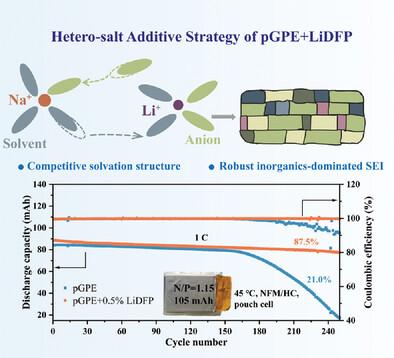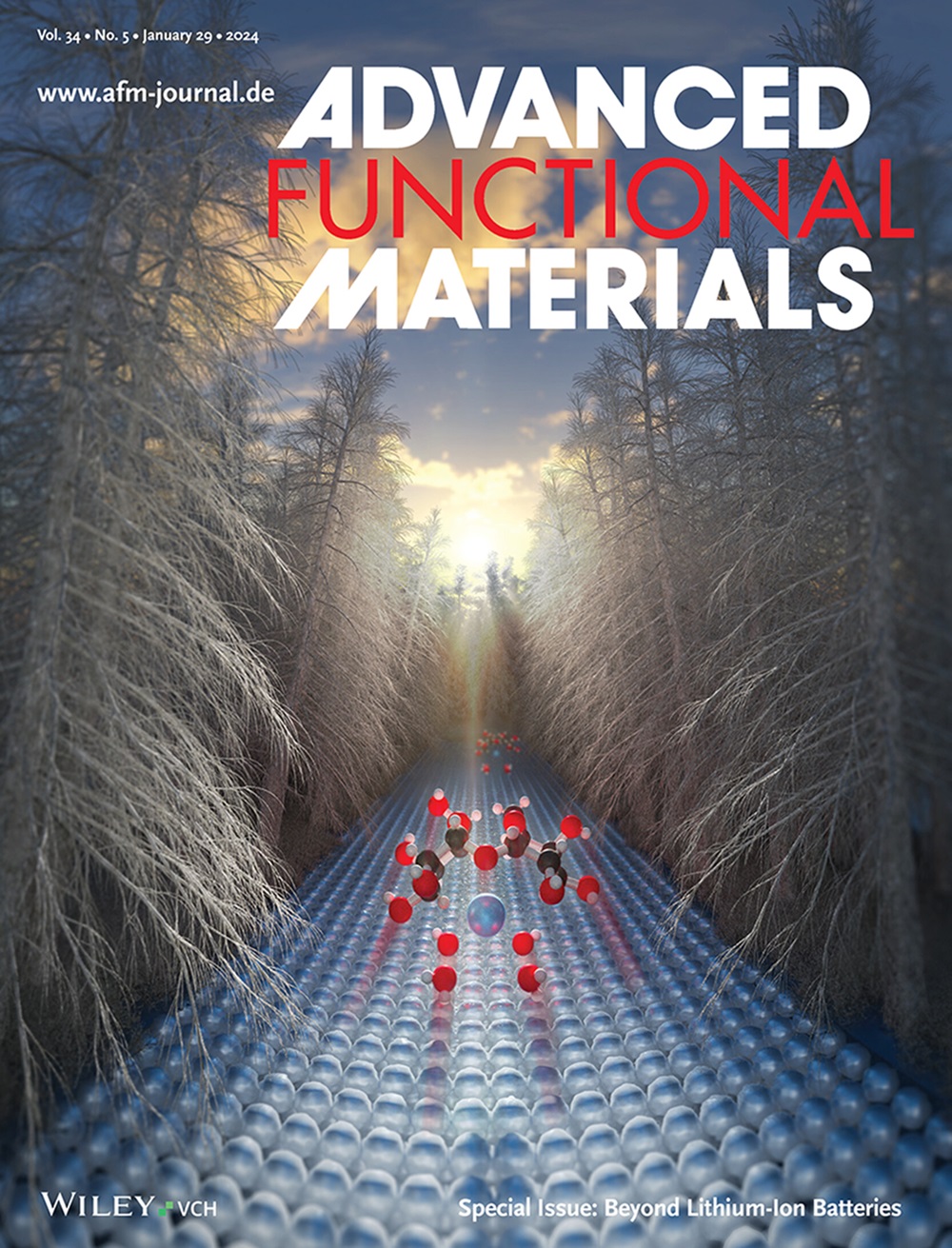Competitive Solvation Structures via Hetero-Salt Additive Strategy Enables Temperature-Adaptive Sodium-Ion Batteries
IF 18.5
1区 材料科学
Q1 CHEMISTRY, MULTIDISCIPLINARY
引用次数: 0
Abstract
Sodium metal batteries (SMBs) are the ultimate choice for high-energy density sodium-based batteries. However, their practicality is still constrained by the uncontrolled side reactions and unstable solid electrolyte interface (SEI) between the electrolyte and Na-metal anode. Herein, a hetero-salt additive (Lithium difluorophosphate, LiDFP) strategy is proposed to optimize the solvation structure of pseudo gel-polymer electrolyte (pGPE) and construct robust SEI on Na metal anode, thereby enhancing Na+ deposition/stripping kinetics. Detailed characterization reveals that Li+ with lower binding energy to solvent molecules can steal solvent molecules from Na+ coordination environment, and then push anions to further coordinate with Na+. The formed anion-enriched solvation structure can assist to restrain side reactions and form a robust inorganics-dominated SEI on Na metal anode. Consequently, such optimization effectively realizes outstanding electrochemical performance of the cells under wide operation temperature (−20 to 70 °C) and prolongs cycling life (1900 h) of Na plating/stripping. Furthermore, paired with commercial NaNi1/3Fe1/3Mn1/3O2 (NFM) cathode and hard carbon (HC) anode, the pouch cell using pGPE+0.5%LiDFP delivers a high-capacity retention of 87.5% at 45 °C after 250 cycles. It is believed that this work affords emerging chances for the rational electrolyte design of stable wide-temperate SIBs.

通过异盐添加剂策略实现竞争性溶解结构,从而实现温度适应性钠离子电池
钠金属电池(SMB)是高能量密度钠基电池的最终选择。然而,它们的实用性仍然受到电解质和钠金属阳极之间不可控的副反应和不稳定的固体电解质界面(SEI)的限制。本文提出了一种杂盐添加剂(二氟磷酸锂,LiDFP)策略,以优化伪凝胶聚合物电解质(pGPE)的溶解结构,并在 Na 金属阳极上构建稳固的 SEI,从而提高 Na+ 沉积/剥离动力学。详细表征显示,与溶剂分子结合能较低的 Li+ 能从 Na+ 配位环境中窃取溶剂分子,然后推动阴离子进一步与 Na+ 配位。所形成的阴离子富集溶解结构有助于抑制副反应,并在 Na 金属阳极上形成以无机物为主的稳健 SEI。因此,这种优化有效地实现了电池在宽工作温度(-20 至 70 °C)下的出色电化学性能,并延长了 Na 镀层/剥离层的循环寿命(1900 小时)。此外,与商用 NaNi1/3Fe1/3Mn1/3O2(NFM)阴极和硬碳(HC)阳极搭配,使用 pGPE+0.5%LiDFP 的袋式电池在 45 ℃ 下循环 250 次后可实现 87.5% 的高容量保持率。相信这项研究为合理设计稳定的宽温带 SIB 电解质提供了新的机遇。
本文章由计算机程序翻译,如有差异,请以英文原文为准。
求助全文
约1分钟内获得全文
求助全文
来源期刊

Advanced Functional Materials
工程技术-材料科学:综合
CiteScore
29.50
自引率
4.20%
发文量
2086
审稿时长
2.1 months
期刊介绍:
Firmly established as a top-tier materials science journal, Advanced Functional Materials reports breakthrough research in all aspects of materials science, including nanotechnology, chemistry, physics, and biology every week.
Advanced Functional Materials is known for its rapid and fair peer review, quality content, and high impact, making it the first choice of the international materials science community.
 求助内容:
求助内容: 应助结果提醒方式:
应助结果提醒方式:


